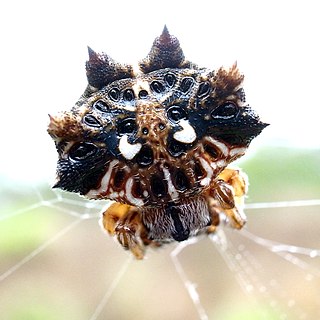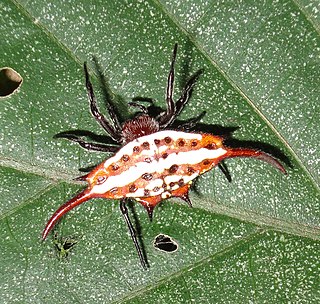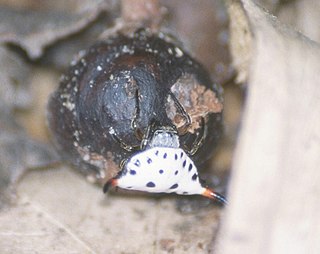
Orb-weaver spiders are members of the spider family Araneidae. They are the most common group of builders of spiral wheel-shaped webs often found in gardens, fields, and forests. The English word "orb" can mean "circular", hence the English name of the group. Araneids have eight similar eyes, hairy or spiny legs, and no stridulating organs.

Gasteracantha is a genus of orb-weaver spiders first named by Carl Jakob Sundevall in 1833. Species of the genus are known as spiny-backed orb-weavers, spiny orb-weavers, or spiny spiders. The females of most species are brightly colored with six prominent spines on their broad, hardened, shell-like abdomens. The name Gasteracantha is derived from the Greek gaster (γαστήρ), meaning "belly, abdomen", and akantha (άκανθα), meaning "thorn, spine". Spiny-backed orb-weavers are sometimes colloquially called "crab spiders" because of their shape, but they are not closely related to the true crab spiders. Other colloquial names for certain species include thorn spider, star spider, kite spider, or jewel spider.
Chorizopes is a genus of orb-weaver spiders first described by O. Pickard-Cambridge in 1871. Though it belongs to the orb weaver family, these spiders move through leaf litter preying on other spiders rather than spinning webs. The original name was "Chorizoopes", but the emendationChorizopes by Tamerlan Thorell is now protected by usage.

Ero is a genus of pirate spiders first described in 1836. They resemble comb-footed spiders due to their globular abdomen, which is higher than it is long.

Thelacantha is a genus of orb-weaver spiders containing the single species, Thelacantha brevispina. It was first described by A. W. M. van Hasselt in 1882, and has been found in Australia, Madagascar, the Indian subcontinent and Southeast Asia, as well as parts of Japan. It has also been introduced into Hawaii. T. brevispina is closely related those in the genus Gasteracantha, and was briefly synonymized with it in 1859, but revalidated in 1974. Saito described three other Thelacantha species in 1933, which were later synonymized with T. brevispina.

Gasteracantha versicolor, known as the long-winged kite spider, is a species of diurnal spiny orb-weaver of the family Araneidae. It is found in the tropics and sub-tropics, where it occurs in forests. It has an extensive range, from central, east and southern Africa to Madagascar.

Box kite spiders (Isoxya) is a genus of Afrotropical orb-weaver spiders first described by Eugène Simon in 1885. Like the spiny orb-weavers they have six prominent spines on their abdomen. They are small spiders, measuring 3 to 7 millimetres across. They have a sclerotised abdomen which is typical of the Gasteracanthinae.

Hortipes is a genus of African corinnid sac spiders first described by J. Bosselaers & J.-C. Ledoux in 1998.
Acantharachne is a genus of African orb-weaver spiders first described by Albert Tullgren in 1910.
Gastroxya is a genus of African orb-weaver spiders first described by Pierre L.G. Benoit in 1962.

Macracantha is a genus of Asian orb-weaver spiders recognized as containing the species, Macracantha arcuata., although some schemes also recognise inclusion of Gasteracantha hasselti in this genus. Macracantha is notable for the extremely long, curved spines on the abdomens of female members of the genus; Eugène Simon created the taxon name from the Greek words μακρός and ἄκανθα (spine). It occurs from India and China through Southeast Asia to Indonesia.
Parmatergus is a genus of East African orb-weaver spiders first described by M. Emerit in 1994. As of April 2019 it contains only three species, all found in Madagascar.

Pasilobus is a genus of orb-weaver spiders first described by Eugène Simon in 1895.

Togacantha is a genus of orb-weaver spiders found in Africa. It is monotypic and contains the single species Togacantha nordviei. It was first described as a subgenus of Gasteracantha by Friedrich Dahl in 1914, and was later elevated to genus status. Only the female was known until a male was found and described in 1982.

Wendilgarda is a genus of ray spiders that was first described by Eugen von Keyserling in 1886.

Robertus mazaurici is a species of araneomorph spider in the family Theridiidae first described by Eugène Simon in 1901.

Cyrtarachninae is a subfamily of spiders in the family Araneidae. The group has been circumscribed in several different ways. It originated as the group Cyrtarachneae, described by Eugène Simon in 1892. The group was later treated at different ranks: as a tribe, both under Simon's name and as Cyrtarachnini, and as the subfamily Cyrtarachninae. Circumscriptions have varied. The broadest circumscription, Cyrtarachninae sensu lato (s.l.), includes three of Simon's original groups, including the bolas spiders. Unlike most araneids, members of the subfamily do not construct orb webs, some not using webs at all to capture prey, some using one or more sticky drops on a single line, while others construct webs with few widely spaced non-spiral threads, some triangular. Many have been shown to attract prey by producing analogues of insect sex pheromones, particularly to attract male moths. Adult females may mimic snails, bird droppings and other objects, and so are able to remain exposed during the day time, capturing prey at night.












